Lignosulfonate Rapidly Inactivates Human Immunodeficiency and Herpes Simplex Viruses
Abstract
:1. Introduction
2. Materials and Methods
2.1. Materials
2.2. Preparation of Lignosulfonate
2.3. Assay for Antiviral Activity
2.3.1. Assay for Anti-HIV Activity (Using Both Long- and Short-Exposure Systems)
2.3.2. Assay for Anti-HSV Activity (Using Only the Short-Exposure System)
2.4. Statistical Treatment
3. Results
3.1. Lignosulfonate Rapidly Inactivates HIV
3.1.1. Lignosulfonate Is the First Class of Anti-HIV Agent (Long-Exposure Experiment)
3.1.2. Enhancement of Anti-HIV Potential of Lignosulfonate by Shortening Treatment Time
3.2. Lignosulfonate Rapidly Inactivates HSV (Short Exposure)
4. Discussion
5. Conclusions
Supplementary Materials
Author Contributions
Funding
Institutional Review Board Statement
Informed Consent Statement
Acknowledgments
Conflicts of Interest
References
- Khadka, D.; Dhamala, M.K.; Li, F.; Aryal, P.C.; Magar, P.R.; Bhatta, S.; Thakur, M.S.; Basnet, A.; Cui, D.; Shi, S. The use of medicinal plants to prevent COVID-19 in Nepal. J. Ethnobiol. Ethnomed. 2021, 17, 26. [Google Scholar] [CrossRef] [PubMed]
- Nguyen, T.T.H.; Jung, J.H.; Kim, M.K.; Lim, S.; Choi, J.M.; Chung, B.; Kim, D.W.; Kim, D. The Inhibitory Effects of Plant Derivate Polyphenols on the Main Protease of SARS Coronavirus 2 and Their Structure-Activity Relationship. Molecules 2021, 26, 1924. [Google Scholar] [CrossRef] [PubMed]
- Sakagami, H. Biological activities and possible dental application of three major groups of polyphenols. J. Pharmacol. Sci. 2014, 126, 92–106. [Google Scholar] [CrossRef] [PubMed] [Green Version]
- Qiu, M.; Wang, Q.; Chu, Y.; Yuan, Z.; Song, H.; Chen, Z.; Wu, Z. Lignosulfonic acid exhibits broadly anti-HIV-1 activity--potential as a microbicide candidate for the prevention of HIV-1 sexual transmission. PLoS ONE 2012, 7, e35906. [Google Scholar] [CrossRef] [PubMed] [Green Version]
- Gordts, S.C.; Férir, G.; D’Huys, T.; Petrova, M.I.; Lebeer, S.; Snoeck, R.; Andrei, G.; Schols, D. The Low-Cost Compound Lignosulfonic Acid (LA) Exhibits Broad-Spectrum Anti-HIV and Anti-HSV Activity and Has Potential for Microbicidal Applications. PLoS ONE 2015, 10, e0131219. [Google Scholar] [CrossRef] [PubMed]
- Oeyen, M.; Noppen, S.; Vanhulle, E.; Claes, S.; Myrvold, B.O.; Vermeire, K.; Schols, D. A unique class of lignin derivatives displays broad anti-HIV activity by interacting with the viral envelope. Virus Res. 2019, 274, 197760. [Google Scholar] [CrossRef]
- Suzuki, H.; Tochikura, T.S.; Iiyama, K.; Yamazaki, S.; Yamamoto, N.; Toda, S. Lignosulfonate, a water-solubilized lignin from the waste liquor of the pulping process, inhibis the infectivity and cytophathic effects of human immunodficiency virus in vitro. Agric. Biol. Chem. 1989, 53, 3369–3372. [Google Scholar]
- Hasegawa, Y.; Kadota, Y.; Hasegawa, C.; Kawaminami, S. Lignosulfonic Acid-Induced Inhibition of Intestinal Glucose Absorption. J. Nutr. Sci. Vitaminol. 2015, 61, 449–454. [Google Scholar] [CrossRef] [Green Version]
- Matsuhisa, K.; Watari, A.; Iwamoto, K.; Kondoh, M.; Yagi, K. Lignosulfonic acid attenuates NF-κB activation and intestinal epithelial barrier dysfunction induced by TNF-α/IFN-γ in Caco-2 cells. J. Nat. Med. 2018, 72, 448–455. [Google Scholar] [CrossRef]
- Pomin, V.H.; Bezerra, F.F.; Soares, P.A.G. Sulfated Glycans in HIV Infection and Therapy. Curr. Pharm. Des. 2017, 23, 3405–3414. [Google Scholar] [CrossRef]
- Cardozo, F.T.; Camelini, C.M.; Leal, P.C.; Kratz, J.M.; Nunes, R.J.; Mendonça, M.M.; Simões, C.M. Antiherpetic mechanism of a sulfated derivative of Agaricus brasiliensis fruiting bodies polysaccharide. Intervirology 2014, 57, 375–383. [Google Scholar] [CrossRef]
- Lewis, N.G.; Yamamoto, E. Lignin: Occurrence, biogenesis and biodegradation. Annu. Rev. Plant Biol. 1990, 41, 455–496. [Google Scholar] [CrossRef] [PubMed]
- Kimura, C.; Li, R.; Ouda, R.; Nishimura, H.; Fujita, T.; Watanabe, T. Production of Antiviral Substance from Sugarcane Bagasse by Chemical Alteration of its Native Lignin Structure through Microwave Solvolysis. ChemSusChem 2020, 13, 4519–4527. [Google Scholar] [CrossRef]
- Mirpoor, S.F.; Restaino, O.F.; Schiraldi, C.; Giosafatto, C.V.L.; Ruffo, F.; Porta, R. Lignin/Carbohydrate Complex Isolated from Posidonia oceanica Sea Balls (Egagropili): Characterization and Antioxidant Reinforcement of Protein-Based Films. Int. J. Mol. Sci. 2021, 22, 9147. [Google Scholar] [CrossRef] [PubMed]
- Zhang, Y.; But, P.P.; Ooi, V.E.; Xu, H.X.; Delaney, G.D.; Lee, S.H.; Lee, S.F. Chemical properties, mode of action, and in vivo anti-herpes activities of a lignin-carbohydrate complex from Prunella vulgaris. Antivir. Res. 2007, 75, 242–249. [Google Scholar] [CrossRef]
- Sakagami, H.; Asano, K.; Yoshida, T.; Kawazoe, Y. Organ distribution and toxicity of lignin. In Vivo 1999, 13, 41–44. [Google Scholar] [PubMed]
- Sakagami, H.; Takeda, M.; Kawazoe, Y.; Nagata, K.; Ishihama, A.; Ueda, M.; Yamazaki, S. Anti-influenza virus activity of a lignin fraction from cone of Pinus parviflora Sieb. et Zucc. In Vivo 1992, 6, 491–495. [Google Scholar]
- Xu, S.; Huang, X.; Gong, Y.; Sun, J. Association between tooth loss rate and risk of mild cognitive impairment in older adults: A population-based longitudinal study. Aging 2021, 13. [Google Scholar] [CrossRef]
- Kusama, T.; Nakazawa, N.; Kiuchi, S.; Kondo, K.; Osaka, K.; Aida, J. Dental prosthetic treatment reduced the risk of weight loss among older adults with tooth loss. J. Am. Geriatr. Soc. 2021, 69, 2498–2506. [Google Scholar] [CrossRef]
- Han, J.Y.; Park, S.H.; Kim, J.; Hwang, K.G.; Park, C.J. Clinical factors affecting the longevity of fixed retainers and the influence of fixed retainers on periodontal health in periodontitis patients: A retrospective study. J. Periodontal Implant. Sci. 2021, 51, 163–178. [Google Scholar] [CrossRef]
- Guidry, J.T.; Scott, R.S. The interaction between human papillomavirus and other viruses. Virus Res. 2017, 231, 139–147. [Google Scholar] [CrossRef] [PubMed] [Green Version]
- Shigeishi, H.; Su, C.Y.; Kaneyasu, Y.; Matsumura, M.; Nakamura, M.; Ishikawa, M.; Saito, A.; Ohta, K.; Sugiyama, M. Association of oral HPV16 infection with periodontal inflammation and the oral microbiome in older women. Exp. Ther. Med. 2021, 21, 167. [Google Scholar] [CrossRef] [PubMed]
- Xu, X.; Dai, Z.; Zhang, Z.; Kou, X.; You, X.; Sun, H.; Guo, H.; Liu, M.; Zhu, H. Fabrication of oral nanovesicle in-situ gel based on Epigallocatechin gallate phospholipid complex: Application in dental anti-caries. Eur. J. Pharmacol. 2021, 897, 173951. [Google Scholar] [CrossRef] [PubMed]
- Landmayer, K.; Liberatti, G.A.; Farias-Neto, A.M.; Wang, L.; Honório, H.M.; Francisconi-Dos-Rios, L.F. Could applying gels containing chlorhexidine, epigallocatechin-3-gallate, or proanthocyanidin to control tooth wear progression improve bond strength to eroded dentin? J. Prosthet. Dent. 2020, 124, 798.e791–798.e797. [Google Scholar] [CrossRef]
- Nakashima, H.; Murakami, T.; Yamamoto, N.; Sakagami, H.; Tanuma, S.; Hatano, T.; Yoshida, T.; Okuda, T. Inhibition of human immunodeficiency viral replication by tannins and related compounds. Antivir. Res. 1992, 18, 91–103. [Google Scholar] [CrossRef]
- Sakagami, H.; Ohkoshi, E.; Amano, S.; Satoh, K.; Kanamoto, T.; Terakubo, S.; Nakashima, H.; Sunaga, K.; Otsuki, T.; Ikeda, H.; et al. Efficient utilization of plant resources by alkaline extraction. Altern. Integr. Med. 2013, 2, 133. [Google Scholar] [CrossRef]
- Ohno, H.; Miyoshi, S.; Araho, D.; Kanamoato, T.; Terakubo, S.; Nakashima, H.; Tsuda, T.; Sunaga, K.; Amano, S.; Ohkoshi, E.; et al. Efficient utilization of licorice root by alkaline extraction. In Vivo 2014, 28, 785–794. [Google Scholar]
- Kato, T.; Horie, N.; Matsuta, T.; Naoki, U.; Shimoyama, T.; Kaneko, T.; Kanamoto, T.; Terakubo, S.; Nakashima, H.; Kusama, K.; et al. Anti-UV/HIV activity of Kampo medicines and constituent plant extracts. In Vivo 2012, 26, 1007–1013. [Google Scholar]
- Chu, Q.; Satoh, K.; Kanamoto, T.; Terakubo, S.; Nakashima, H.; Wang, Q.; Sakagami, H. Antitumor potential of three herbal extracts against human oral squamous cell lines. Anticancer Res. 2009, 29, 3211–3219. [Google Scholar]
- Sakagami, H.; Zhou, L.; Kawano, M.; Thet, M.M.; Tanaka, S.; Machino, M.; Amano, S.; Kuroshita, R.; Watanabe, S.; Chu, Q.; et al. Multiple biological complex of alkaline extract of the leaves of Sasa senanensis Rehder. In Vivo 2010, 24, 735–743. [Google Scholar]
- Sakagami, H.; Kushida, T.; Oizumi, T.; Nakashima, H.; Makino, T. Distribution of lignin-carbohydrate complex in plant kingdom and its functionality as alternative medicine. Pharmacol. Ther. 2010, 128, 91–105. [Google Scholar] [CrossRef]
- Fukuchi, K.; Sakagami, H.; Sugita, Y.; Takao, K.; Asai, D.; Terakubo, S.; Takemura, H.; Ohno, H.; Horiuchi, M.; Suguro, M.; et al. Quantification of the Ability of Natural Products to Prevent Herpes Virus Infection. Medicines 2020, 7, 64. [Google Scholar] [CrossRef]
- Glennie, D.W. Reactions in sulfite pulping. In Lignins, Occurrence, Formation, Structure and Reactions; Sarkanen, K.V., Ludwig, C.H., Eds.; Wiley-Interscience: New York, NY, USA; Sydney, Australia; Toronto, ON, Canada, 1971; p. 607. [Google Scholar]
- Nakashima, H.; Masuda, M.; Murakami, T.; Koyanagi, Y.; Matsumoto, A.; Fujii, N.; Yamamoto, N. Anti-human immunodeficiency virus activity of a novel synthetic peptide, T22 ([Tyr-5,12, Lys-7] polyphemusin II): A possible inhibitor of virus-cell fusion. Antimicrob. Agents Chemother. 1992, 36, 1249–1255. [Google Scholar] [CrossRef] [Green Version]
- Koizumi, N.; Sakagami, H.; Utsumi, A.; Fujinaga, S.; Takeda, M.; Asano, K.; Sugawara, I.; Ichikawa, S.; Kondo, H.; Mori, S.; et al. Anti-HIV (human immunodeficiency virus) activity of sulfated paramylon. Antivir. Res. 1993, 21, 1–14. [Google Scholar] [CrossRef]
- Nakashima, H.; Murakami, T.; Yamamoto, N.; Naoe, T.; Kawazoe, Y.; Konno, K.; Sakagami, H. Lignified materials as medicinal resources. V. Anti-HIV (human immunodeficiency virus) activity of some synthetic lignins. Chem. Pharm. Bull. 1992, 40, 2102–2105. [Google Scholar] [CrossRef] [PubMed] [Green Version]
- Shimada, C.; Uesawa, Y.; Ishii-Nozawa, R.; Ishihara, M.; Kagaya, H.; Kanamoto, T.; Terakubo, S.; Nakashima, H.; Takao, K.; Sugita, Y.; et al. Quantitative structure-cytotoxicity relationship of 3-styrylchromones. Anticancer Res. 2014, 34, 5405–5411. [Google Scholar] [PubMed]
- Uesawa, Y.; Sakagami, H.; Ishihara, M.; Kagaya, H.; Kanamoto, T.; Terakubo, S.; Nakashima, H.; Yahagi, H.; Takao, K.; Sugita, Y. Quantitative Structure-Cytotoxicity Relationship of 3-Styryl-2H-chromenes. Anticancer Res. 2015, 35, 5299–5307. [Google Scholar] [PubMed]
- Sakagami, H.; Masuda, Y.; Tomomura, M.; Yokose, S.; Uesawa, Y.; Ikezoe, N.; Asahara, D.; Takao, K.; Kanamoto, T.; Terakubo, S.; et al. Quantitative Structure-Cytotoxicity Relationship of Chalcones. Anticancer Res. 2017, 37, 1091–1098. [Google Scholar] [CrossRef] [PubMed] [Green Version]
- Jung, H.; Kwon, S.; Kim, J.H.; Jeon, J.R. Which Traits of Humic Substances Are Investigated to Improve Their Agronomical Value? Molecules 2021, 26, 760. [Google Scholar] [CrossRef]
- Harada, H.; Sakagami, H.; Nagata, K.; Oh-hara, T.; Kawazoe, Y.; Ishihama, A.; Hata, N.; Misawa, Y.; Terada, H.; Konno, K. Possible involvement of lignin structure in anti-influenza virus activity. Antivir. Res. 1991, 15, 41–49. [Google Scholar] [CrossRef]
- Lai, P.K.; Oh-hara, T.; Tamura, Y.; Kawazoe, Y.; Konno, K.; Sakagami, H.; Tanaka, A.; Nonoyama, M. Polymeric phenylpropenoids are the active components in the pine cone extract that inhibit the replication of type-1 human immunodeficiency virus in vitro. J. Gen. Appl. Microbiol. 1992, 38, 303–323. [Google Scholar] [CrossRef] [Green Version]
- Sakagami, H.; Amano, S.; Yasui, T.; Satoh, K.; Shioda, S.; Kanamoto, T.; Terakubo, S.; Nakashima, H.; Watanabe, K.; Sugiura, T.; et al. Biological interaction between Sasa senanensis Rehder leaf extract and toothpaste ingredients. In Vivo 2013, 27, 275–284. [Google Scholar]
- Sakagami, H.; Fukuchi, K.; Kanamoto, T.; Terakubo, S.; Nakashima, H.; Natori, T.; Suguro-Kitajima, M.; Oizumi, H.; Yasui, T.; Oizumi, T. Synergism of Alkaline Extract of the Leaves of Sasa senanensis Rehder and Antiviral Agents. In Vivo 2016, 30, 421–426. [Google Scholar] [PubMed]
- Crimi, S.; Fiorillo, L.; Bianchi, A.; D’Amico, C.; Amoroso, G.; Gorassini, F.; Mastroieni, R.; Marino, S.; Scoglio, C.; Catalano, F.; et al. Herpes Virus, Oral Clinical Signs and QoL: Systematic Review of Recent Data. Viruses 2019, 11, 463. [Google Scholar] [CrossRef] [Green Version]
- Shugars, D.C.; Patton, L.L.; Freel, S.A.; Gray, L.R.; Vollmer, R.T.; Eron, J.J., Jr.; Fiscus, S.A. Hyper-excretion of human immunodeficiency virus type 1 RNA in saliva. J. Dent. Res. 2001, 80, 414–420. [Google Scholar] [CrossRef] [PubMed]
- Matsuta, T.; Sakagami, H.; Tanaka, S.; Machino, M.; Tomomura, M.; Tomomura, A.; Yasui, T.; Itoh, K.; Sugiura, T.; Kitajima, M.; et al. Pilot clinical study of Sasa senanensis Rehder leaf extract treatment on lichenoid dysplasia. In Vivo 2012, 26, 957–962. [Google Scholar] [PubMed]
- Sakagami, H.; Nakatani, S.; Enomoto, A.; Ota, S.; Kaneko, M.; Sugimoto, M.; Horiuchi, M.; Toeda, K.; Oizumi, T. Multi-Omics Analysis of Anti-Inflammatory Action of Alkaline Extract of the Leaves of Sasa sp. J. Clin. Med. 2021, 10, 2100. [Google Scholar] [CrossRef]
- Andrew, M.; Jayaraman, G. Marine sulfated polysaccharides as potential antiviral drug candidates to treat Corona Virus disease (COVID-19). Carbohydr. Res. 2021, 505, 108326. [Google Scholar] [CrossRef]
- Cirillo, N. Taste alteration in COVID-19: Significant geographical differences exist in the prevalence of the symptom. J. Infect. Public Health 2021, 14, 1099–1105. [Google Scholar] [CrossRef]
- Doty, R.L. The mechanisms of smell loss after SARS-CoV-2 infection. Lancet Neurol. 2021, 20, 693–695. [Google Scholar] [CrossRef]
- Yuan, H.; Yang, Q.; Yang, B.; Xu, H.; Nasif, O.; Muruganantham, S.; Chen, J. Phyllanthin Averts Oxidative Stress and Neuroinflammation in Cerebral Ischemic-Reperfusion Injury through Modulation of the NF-κB and AMPK/Nrf2 Pathways. J. Environ. Pathol. Toxicol. Oncol. 2021, 40, 85–97. [Google Scholar] [CrossRef] [PubMed]
- Sakagami, H.; Shi, H.; Bandow, K.; Tomomura, M.; Tomomura, A.; Horiuchi, M.; Fujisawa, T.; Oizumi, T. Search of Neuroprotective Polyphenols Using the “Overlay” Isolation Method. Molecules 2018, 23, 1840. [Google Scholar] [CrossRef] [Green Version]
- Kushida, T.; Makino, T.; Tomomura, M.; Tomomura, A.; Sakagami, H. Enhancement of Dectin-2 gene expression by lignin-carbohydrate complex from Lentinus edodes mycelia extract (LEM) in a mouse macrophage-like cell line. Anticancer Res. 2011, 31, 1241–1248. [Google Scholar] [PubMed]
- Kitai, Y.; Sato, K.; Tanno, D.; Yuan, X.; Umeki, A.; Kasamatsu, J.; Kanno, E.; Tanno, H.; Hara, H.; Yamasaki, S.; et al. Role of Dectin-2 in the phagocytosis of Cryptococcus neoformans by dendritic cells. Infect. Immun. 2021, 89, e0033021. [Google Scholar] [CrossRef] [PubMed]
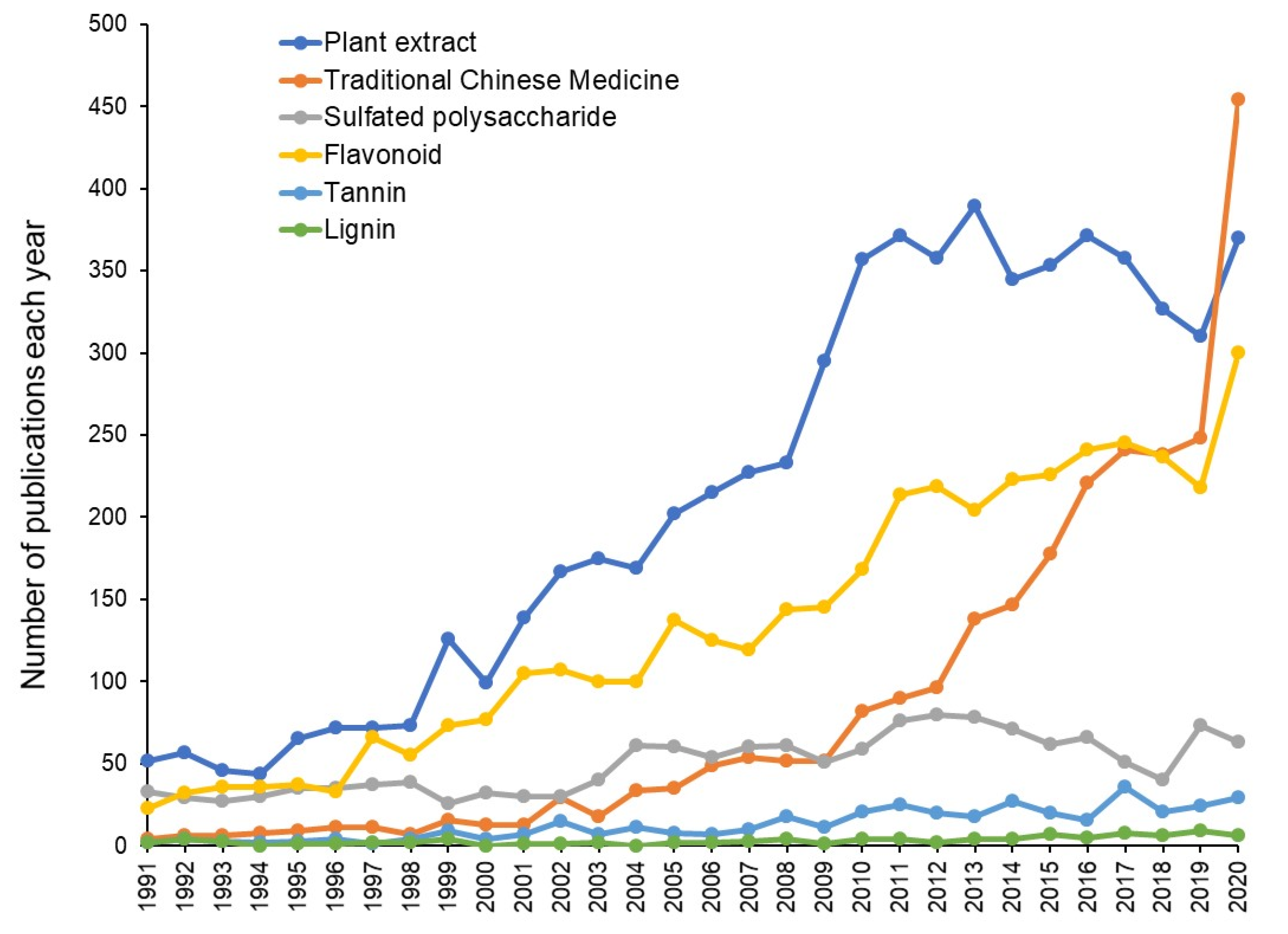
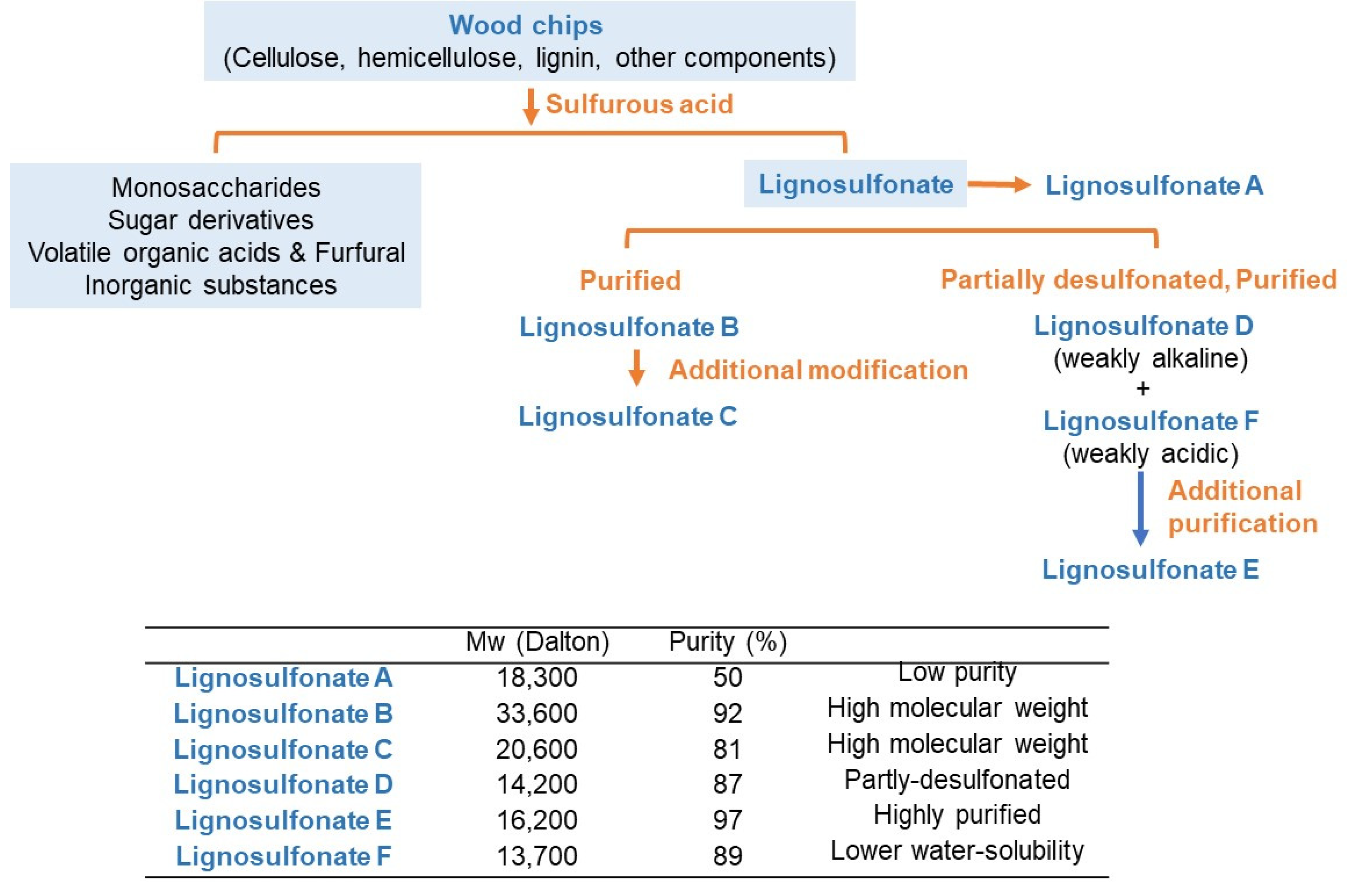

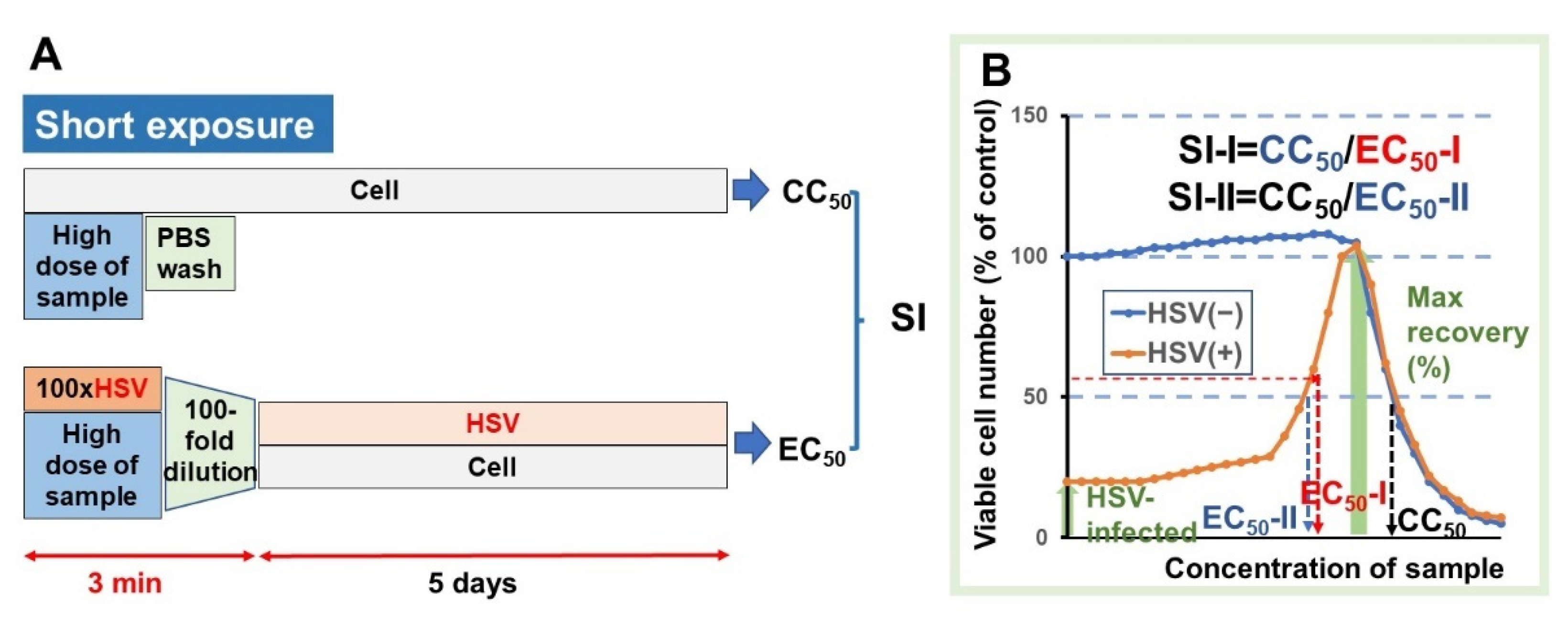
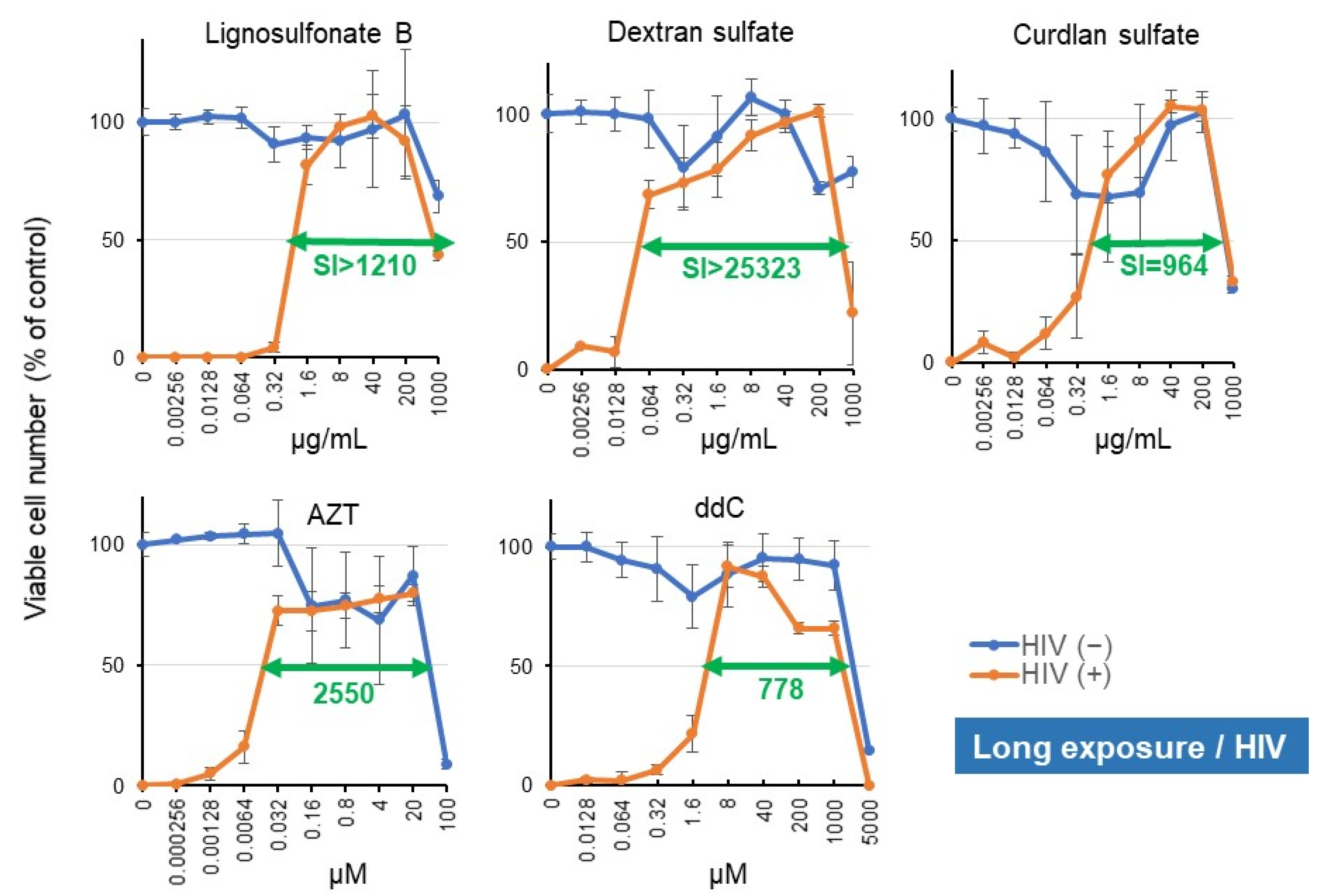
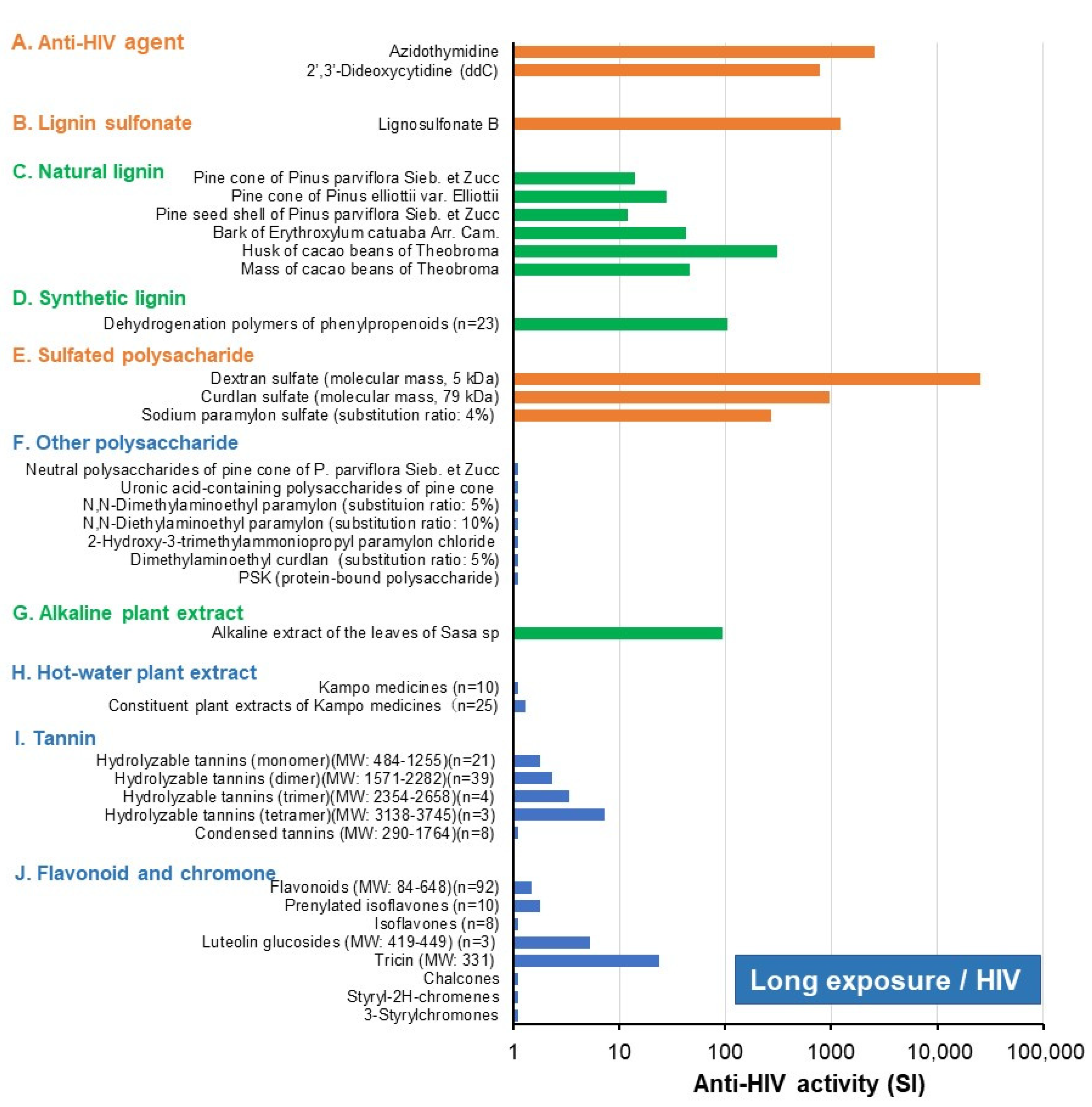
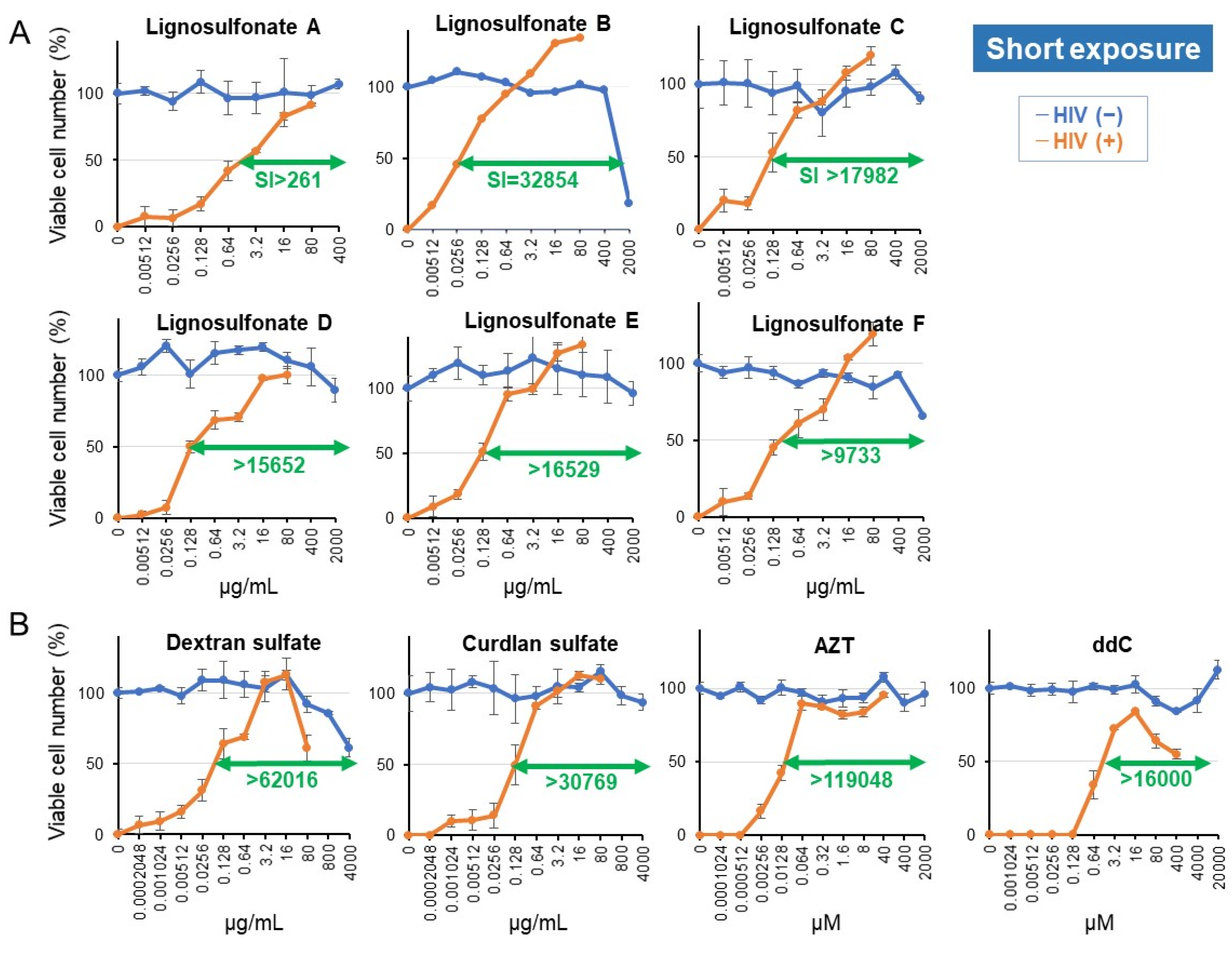

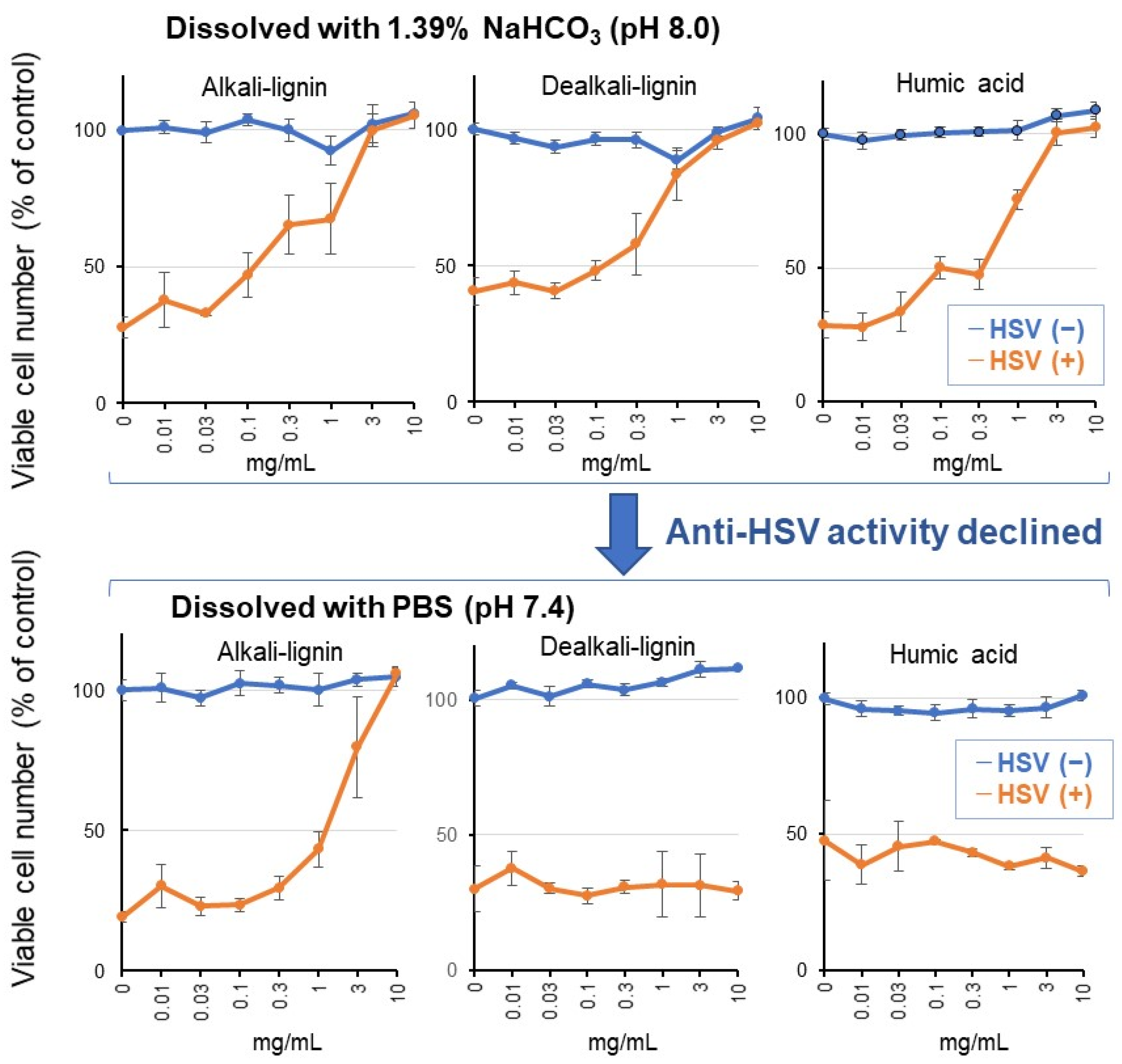
| Number of Papers Reported Thus Far | ||||
|---|---|---|---|---|
| Classification | Subgroup | Antiviral | Anti-HIV | Anti-HSV |
| Plant extracts | Plant extracts | 6173 | 564 | 126 |
| (Group 1) | Traditional Chinese medicine | 2429 | 119 | 20 |
| Kampo medicine | 67 | 3 | 2 | |
| Hot water extract | 79 | 9 | 6 | |
| Alkaline extract | 92 | 16 | 4 | |
| Flavonoid | Flavonoid | 3911 | 234 | 48 |
| (Group 2) | Flavonol | 596 | 19 | 5 |
| Flavone | 4 | 0 | 0 | |
| Flavanone | 249 | 18 | 1 | |
| Isoflavone | 513 | 12 | 3 | |
| Pterocarpan | 12 | 3 | 0 | |
| Coumestan | 5 | 1 | 0 | |
| Resveratrol | 328 | 25 | 2 | |
| Curcumin | 488 | 31 | 0 | |
| Tricin | 15 | 2 | 0 | |
| Tannins | Tannin | 388 | 60 | 16 |
| (Group 3) | Hydrolyzable tannin | 124 | 11 | 7 |
| Condensed tannin | 99 | 10 | 2 | |
| Procyanidine | 51 | 8 | 2 | |
| Gallic acid | 322 | 28 | 18 | |
| Epigallocatechin gallate | 260 | 21 | 1 | |
| Catechin | 487 | 38 | 8 | |
| Polysaccharides | Polysaccharide | 16165 | 656 | 51 |
| (Group 4) | Sulfated polysaccharide | 1588 | 229 | 31 |
| Lignin | Lignin | 98 | 32 | 5 |
| (Group 5) | Synthetic lignin | 10 | 6 | 0 |
| Lignosulfonate | 5 | 3 | 1 | |
| p-Coumaric acid | 28 | 8 | 1 | |
| Test Compound | Data Source | CC50 (μg/mL) | EC50 (μg/mL) | SI |
|---|---|---|---|---|
| <Short exposure> | ||||
| Lignosulfonate A | Figure 4 | >400 | 1.53 | >261 |
| Lignosulfonate B | 1056 | 0.0322 | 32,854 | |
| Lignosulfonate C | >2000 | 0.111 | >17,982 | |
| Lignosulfonate D | >2000 | 0.128 | >15,625 | |
| Lignosulfonate E | >2000 | 0.121 | >16,529 | |
| Lignosulfonate F | >2000 | 0.205 | >9733 | |
| Dextran sulfate | >4000 | 0.0645 | >62,016 | |
| Curdlan sulfate | >4000 | 0.130 | >30,769 | |
| AZT (μM) | >2000 | 0.0168 | >119,048 | |
| ddC (μM) | >20,000 | 1.25 | >16,000 | |
| <Long exposure> | ||||
| Lignosulfonate B | Figure 2 | >1000 | 0.826 | >1210 |
| Dextran sulfate | >1000 | 0.0395 | >25,323 | |
| Curdlan sulfate | 644 | 0.668 | 964 | |
| AZT (μM) | 42.9 | 0.0168 | 2550 | |
| ddC (μM) | 2387 | 3.07 | 778 | |
| Dextran sulfate | Supplementary Figure S2 | 138 | 0.0593 | 2321 |
| Curdlan sulfate | (Exp. 1) | 914 | 0.208 | 4392 |
| AZT (μM) | 167 | 0.0165 | 10,090 | |
| ddC (μM) | 2450 | 3.62 | 677 | |
| Dextran sulfate | (Exp. 2) | 155 | 0.0419 | 3703 |
| Curdlan sulfate | 480 | 0.133 | 3614 | |
| AZT (μM) | 47.4 | 0.00980 | 4838 | |
| ddC (μM) | >5000 | 3.88 | >1289 |
| Test Compound | Solvent | Viability of HSV- Infected Cells (%) | CC50 (mg/mL) | EC50-I (mg/mL) | EC50-II (mg/mL) | SI-I | SI-II | Max Recovery (%) |
|---|---|---|---|---|---|---|---|---|
| <Lignosulfonate> | ||||||||
| Lignosulfonate A | NaHCO3 | 23.9 | >10 | 3.5 | 1.6 | >2.9 | >6.3 | 119 |
| PBS | 23.4 | >10 | 2.8 | 2 | >3.6 | >5 | 112 | |
| Lignosulfonate B | NaHCO3 | 43.5 | >10 | 0.52 | 0.35 | >19.2 | >28.6 | 117 |
| PBS | 48.2 | >10 | 0.71 | 0.46 | >14.1 | >21.7 | 120 | |
| Lignosulfonate C | NaHCO3 | 29.9 | >10 | 0.74 | 0.55 | >13.5 | >18.2 | 110 |
| PBS | 34.2 | >10 | 1.6 | 1.2 | >6.3 | >8.3 | 114 | |
| Lignosulfonate D | NaHCO3 | 35.3 | >10 | 1.4 | 0.32 | >7.1 | >31.3 | 91 |
| PBS | 43 | >10 | 2.6 | 1.1 | >3.8 | >9.1 | 83 | |
| Lignosulfonate E | NaHCO3 | 35.5 | >10 | 1.6 | 0.96 | >6.3 | >10.4 | 106 |
| PBS | 23.5 | >10 | 0.62 | 0.46 | >16.1 | >21.7 | 108 | |
| Lignosulfonate F | NaHCO3 | 24 | >10 | 1.1 | 0.45 | >9.1 | >22.2 | 117 |
| PBS | 33 | >10 | 5.5 | 4.4 | >1.8 | >2.3 | 112 | |
| <Other lignified materials> | ||||||||
| Alkali-lignin | NaHCO3 | 27.7 | >10 | 0.28 | 0.12 | >35.7 | >83.3 | 100 |
| PBS | 19.1 | >10 | 1.8 | 1.4 | >5.6 | >7.1 | 106 | |
| Dealkali-lignin | NaHCO3 | 40.67 | >10 | 0.56 | 0.13 | >17.9 | >76.9 | 102 |
| PBS | 30.3 | >10 | - | - | - | - | - | |
| Humic acid | NaHCO3 | 28.5 | >10 | 0.6 | 0.34 | >16.7 | >29.4 | 100 |
| PBS | 47.6 | >10 | - | - | - | - | - | |
Publisher’s Note: MDPI stays neutral with regard to jurisdictional claims in published maps and institutional affiliations. |
© 2021 by the authors. Licensee MDPI, Basel, Switzerland. This article is an open access article distributed under the terms and conditions of the Creative Commons Attribution (CC BY) license (https://creativecommons.org/licenses/by/4.0/).
Share and Cite
Fukuchi, K.; Koshikawa, T.; Asai, D.; Inomata, M.; Sakagami, H.; Takemura, H.; Kanamoto, T.; Aimi, H.; Kikkawa, Y. Lignosulfonate Rapidly Inactivates Human Immunodeficiency and Herpes Simplex Viruses. Medicines 2021, 8, 56. https://doi.org/10.3390/medicines8100056
Fukuchi K, Koshikawa T, Asai D, Inomata M, Sakagami H, Takemura H, Kanamoto T, Aimi H, Kikkawa Y. Lignosulfonate Rapidly Inactivates Human Immunodeficiency and Herpes Simplex Viruses. Medicines. 2021; 8(10):56. https://doi.org/10.3390/medicines8100056
Chicago/Turabian StyleFukuchi, Kunihiko, Takuro Koshikawa, Daisuke Asai, Megumi Inomata, Hiroshi Sakagami, Hiromu Takemura, Taisei Kanamoto, Hikaru Aimi, and Yuji Kikkawa. 2021. "Lignosulfonate Rapidly Inactivates Human Immunodeficiency and Herpes Simplex Viruses" Medicines 8, no. 10: 56. https://doi.org/10.3390/medicines8100056
APA StyleFukuchi, K., Koshikawa, T., Asai, D., Inomata, M., Sakagami, H., Takemura, H., Kanamoto, T., Aimi, H., & Kikkawa, Y. (2021). Lignosulfonate Rapidly Inactivates Human Immunodeficiency and Herpes Simplex Viruses. Medicines, 8(10), 56. https://doi.org/10.3390/medicines8100056







